Report: Technology Based Training Methods Analysis
VerifiedAdded on 2022/09/18
|9
|1536
|30
Report
AI Summary
This report examines technology-based training methods, focusing on their application within a company context, with Nokia as a case study. It details the advantages, including flexibility, reduced training costs, enhanced employee performance, increased customer base, mobility, improved information retention, global collaboration, and timely feedback. The report also critically analyzes the disadvantages, such as less interaction, lack of control, employee isolation, and the potential for a lack of self-discipline. The discussion integrates relevant research to support its claims, ultimately concluding that while technology-based training offers significant benefits, organizations must address its drawbacks to optimize employee development and organizational effectiveness. The report underscores the need for a balanced approach, leveraging technology's strengths while mitigating its weaknesses.
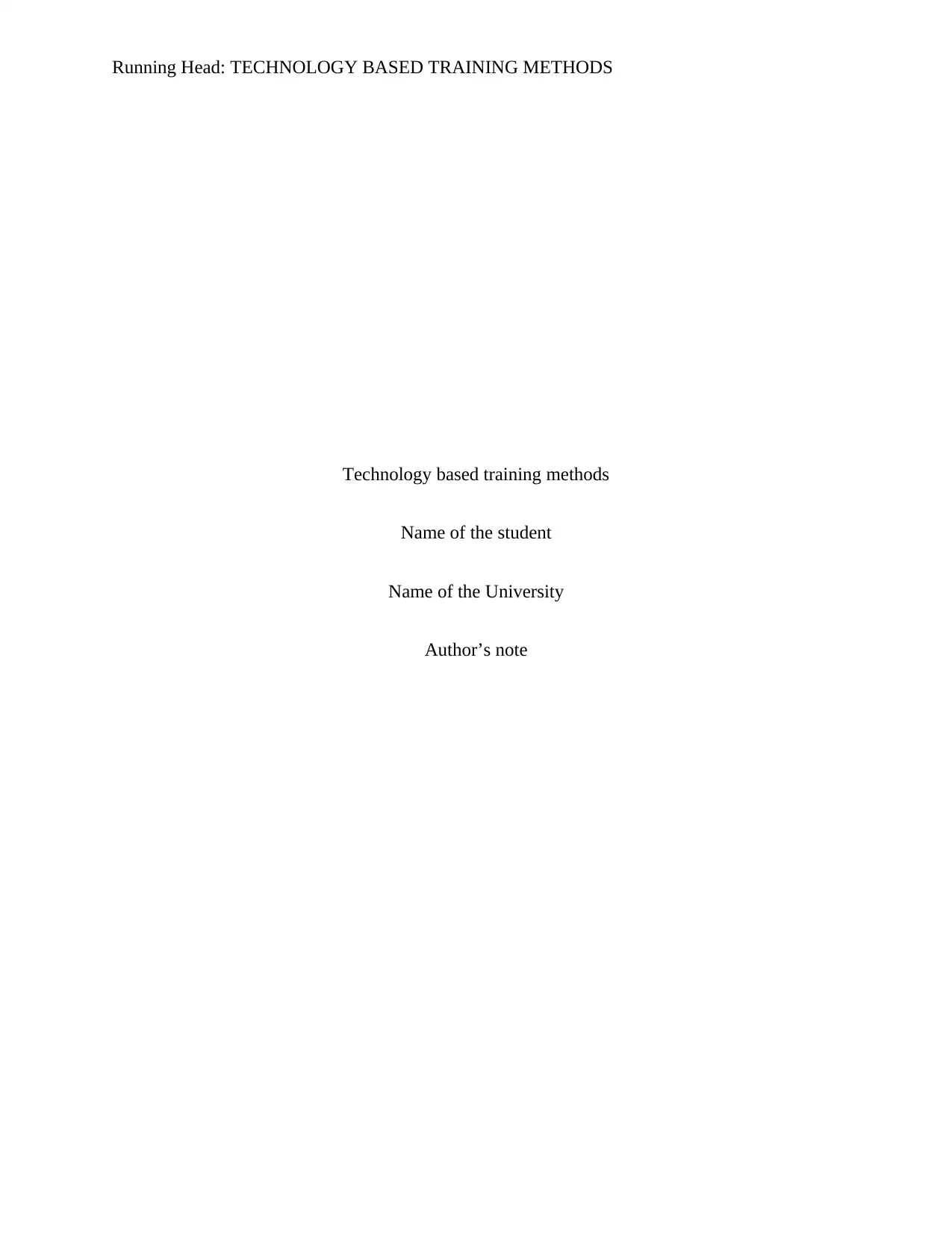
Running Head: TECHNOLOGY BASED TRAINING METHODS
Technology based training methods
Name of the student
Name of the University
Author’s note
Technology based training methods
Name of the student
Name of the University
Author’s note
Paraphrase This Document
Need a fresh take? Get an instant paraphrase of this document with our AI Paraphraser
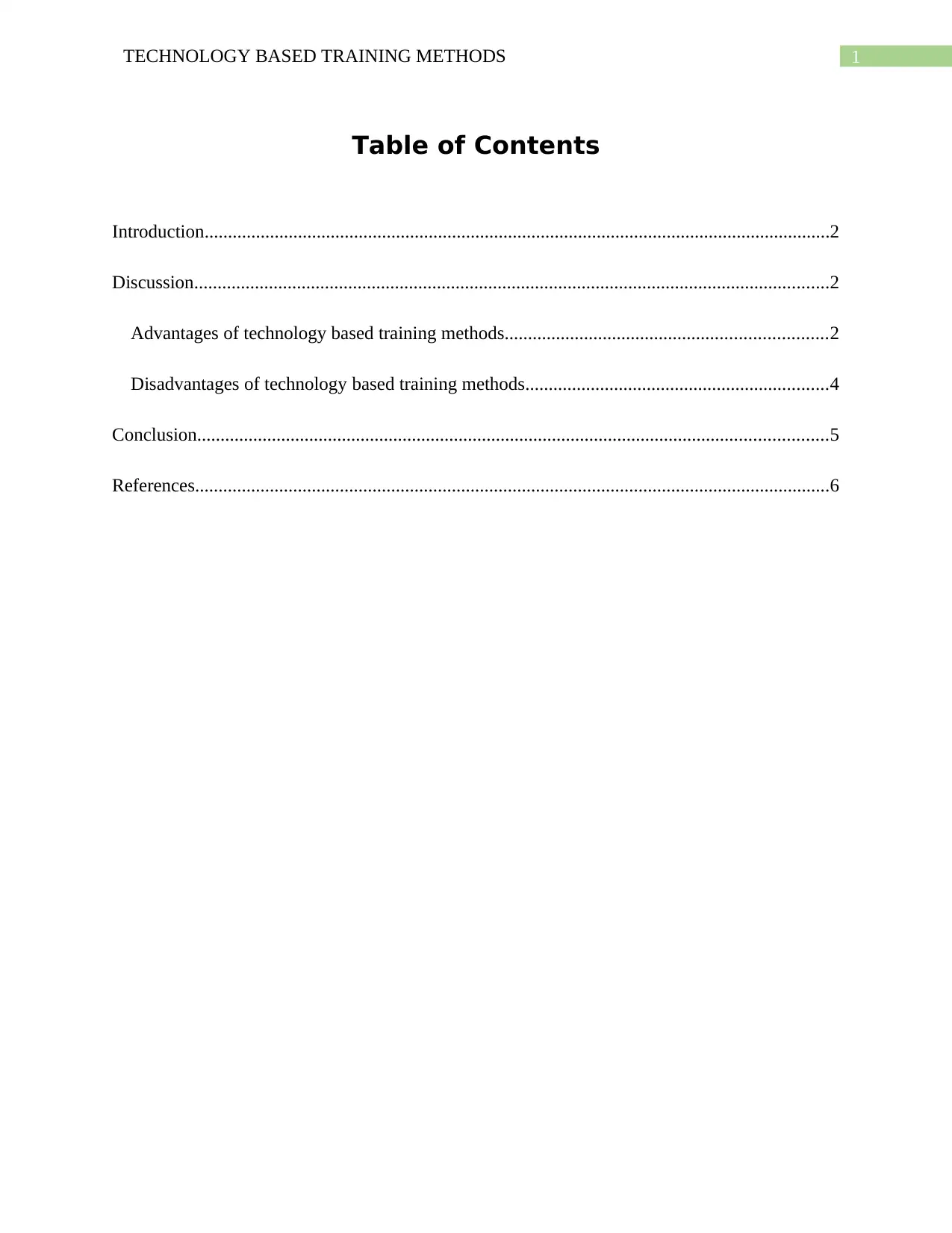
1TECHNOLOGY BASED TRAINING METHODS
Table of Contents
Introduction......................................................................................................................................2
Discussion........................................................................................................................................2
Advantages of technology based training methods.....................................................................2
Disadvantages of technology based training methods.................................................................4
Conclusion.......................................................................................................................................5
References........................................................................................................................................6
Table of Contents
Introduction......................................................................................................................................2
Discussion........................................................................................................................................2
Advantages of technology based training methods.....................................................................2
Disadvantages of technology based training methods.................................................................4
Conclusion.......................................................................................................................................5
References........................................................................................................................................6
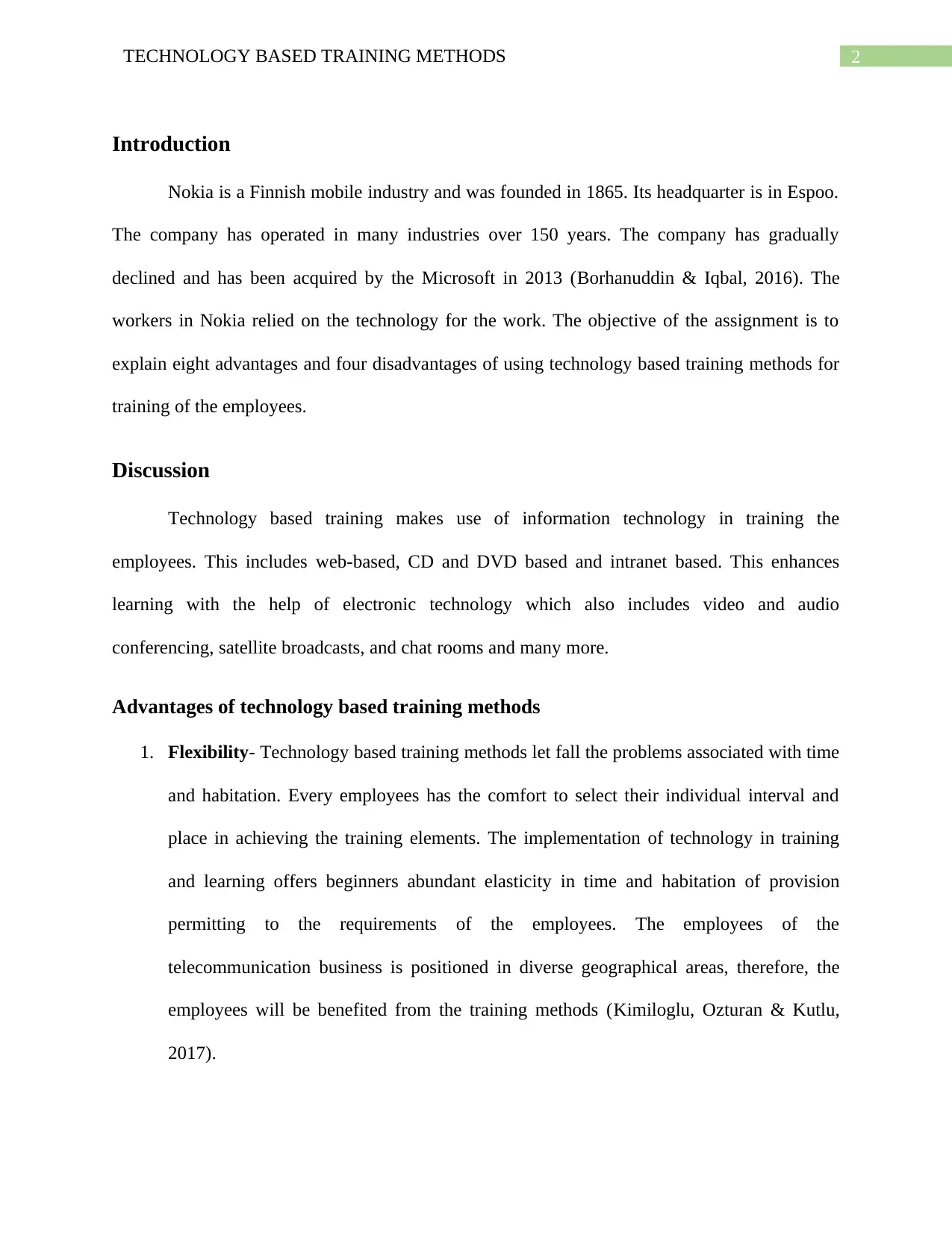
2TECHNOLOGY BASED TRAINING METHODS
Introduction
Nokia is a Finnish mobile industry and was founded in 1865. Its headquarter is in Espoo.
The company has operated in many industries over 150 years. The company has gradually
declined and has been acquired by the Microsoft in 2013 (Borhanuddin & Iqbal, 2016). The
workers in Nokia relied on the technology for the work. The objective of the assignment is to
explain eight advantages and four disadvantages of using technology based training methods for
training of the employees.
Discussion
Technology based training makes use of information technology in training the
employees. This includes web-based, CD and DVD based and intranet based. This enhances
learning with the help of electronic technology which also includes video and audio
conferencing, satellite broadcasts, and chat rooms and many more.
Advantages of technology based training methods
1. Flexibility- Technology based training methods let fall the problems associated with time
and habitation. Every employees has the comfort to select their individual interval and
place in achieving the training elements. The implementation of technology in training
and learning offers beginners abundant elasticity in time and habitation of provision
permitting to the requirements of the employees. The employees of the
telecommunication business is positioned in diverse geographical areas, therefore, the
employees will be benefited from the training methods (Kimiloglu, Ozturan & Kutlu,
2017).
Introduction
Nokia is a Finnish mobile industry and was founded in 1865. Its headquarter is in Espoo.
The company has operated in many industries over 150 years. The company has gradually
declined and has been acquired by the Microsoft in 2013 (Borhanuddin & Iqbal, 2016). The
workers in Nokia relied on the technology for the work. The objective of the assignment is to
explain eight advantages and four disadvantages of using technology based training methods for
training of the employees.
Discussion
Technology based training makes use of information technology in training the
employees. This includes web-based, CD and DVD based and intranet based. This enhances
learning with the help of electronic technology which also includes video and audio
conferencing, satellite broadcasts, and chat rooms and many more.
Advantages of technology based training methods
1. Flexibility- Technology based training methods let fall the problems associated with time
and habitation. Every employees has the comfort to select their individual interval and
place in achieving the training elements. The implementation of technology in training
and learning offers beginners abundant elasticity in time and habitation of provision
permitting to the requirements of the employees. The employees of the
telecommunication business is positioned in diverse geographical areas, therefore, the
employees will be benefited from the training methods (Kimiloglu, Ozturan & Kutlu,
2017).
⊘ This is a preview!⊘
Do you want full access?
Subscribe today to unlock all pages.

Trusted by 1+ million students worldwide
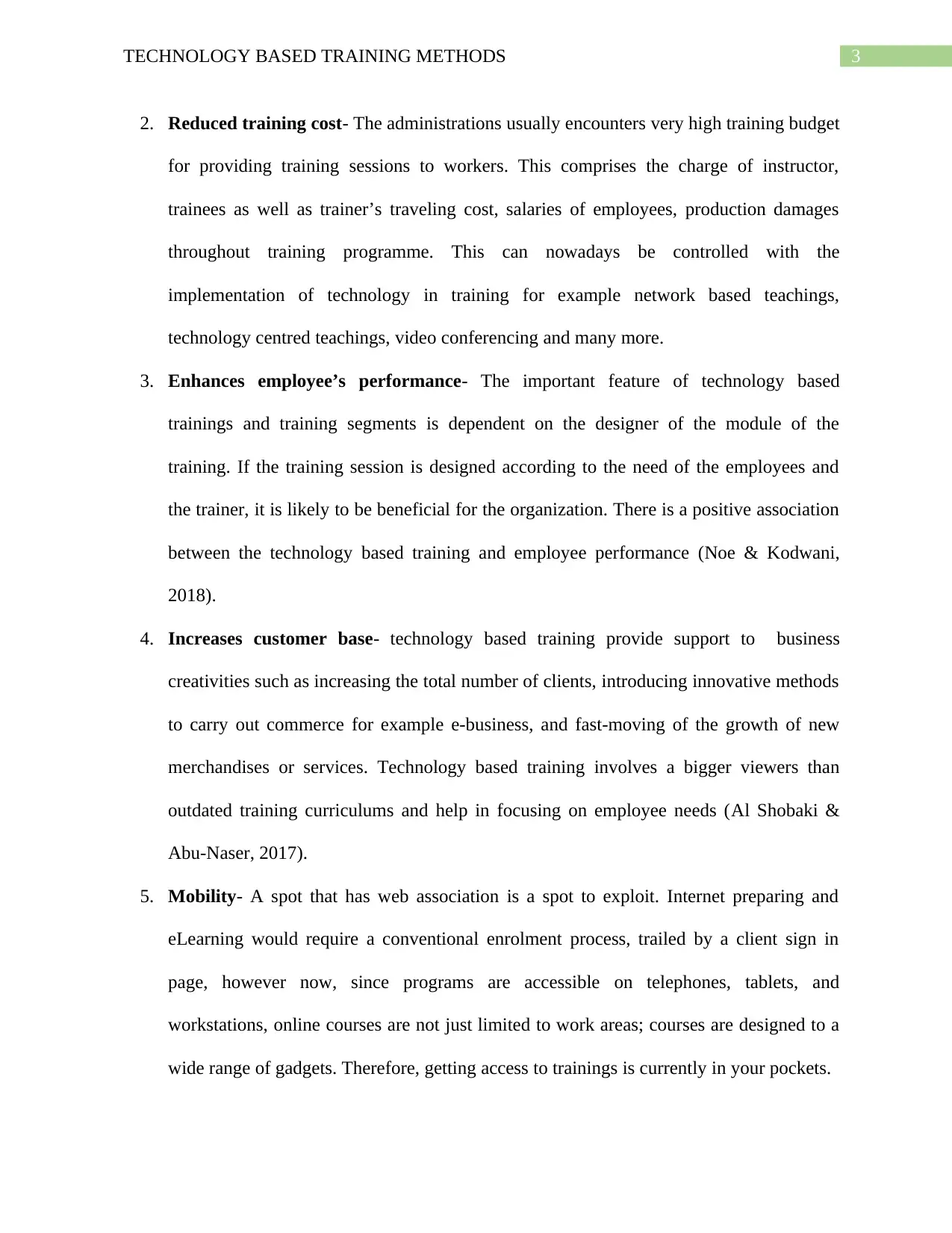
3TECHNOLOGY BASED TRAINING METHODS
2. Reduced training cost- The administrations usually encounters very high training budget
for providing training sessions to workers. This comprises the charge of instructor,
trainees as well as trainer’s traveling cost, salaries of employees, production damages
throughout training programme. This can nowadays be controlled with the
implementation of technology in training for example network based teachings,
technology centred teachings, video conferencing and many more.
3. Enhances employee’s performance- The important feature of technology based
trainings and training segments is dependent on the designer of the module of the
training. If the training session is designed according to the need of the employees and
the trainer, it is likely to be beneficial for the organization. There is a positive association
between the technology based training and employee performance (Noe & Kodwani,
2018).
4. Increases customer base- technology based training provide support to business
creativities such as increasing the total number of clients, introducing innovative methods
to carry out commerce for example e-business, and fast-moving of the growth of new
merchandises or services. Technology based training involves a bigger viewers than
outdated training curriculums and help in focusing on employee needs (Al Shobaki &
Abu-Naser, 2017).
5. Mobility- A spot that has web association is a spot to exploit. Internet preparing and
eLearning would require a conventional enrolment process, trailed by a client sign in
page, however now, since programs are accessible on telephones, tablets, and
workstations, online courses are not just limited to work areas; courses are designed to a
wide range of gadgets. Therefore, getting access to trainings is currently in your pockets.
2. Reduced training cost- The administrations usually encounters very high training budget
for providing training sessions to workers. This comprises the charge of instructor,
trainees as well as trainer’s traveling cost, salaries of employees, production damages
throughout training programme. This can nowadays be controlled with the
implementation of technology in training for example network based teachings,
technology centred teachings, video conferencing and many more.
3. Enhances employee’s performance- The important feature of technology based
trainings and training segments is dependent on the designer of the module of the
training. If the training session is designed according to the need of the employees and
the trainer, it is likely to be beneficial for the organization. There is a positive association
between the technology based training and employee performance (Noe & Kodwani,
2018).
4. Increases customer base- technology based training provide support to business
creativities such as increasing the total number of clients, introducing innovative methods
to carry out commerce for example e-business, and fast-moving of the growth of new
merchandises or services. Technology based training involves a bigger viewers than
outdated training curriculums and help in focusing on employee needs (Al Shobaki &
Abu-Naser, 2017).
5. Mobility- A spot that has web association is a spot to exploit. Internet preparing and
eLearning would require a conventional enrolment process, trailed by a client sign in
page, however now, since programs are accessible on telephones, tablets, and
workstations, online courses are not just limited to work areas; courses are designed to a
wide range of gadgets. Therefore, getting access to trainings is currently in your pockets.
Paraphrase This Document
Need a fresh take? Get an instant paraphrase of this document with our AI Paraphraser
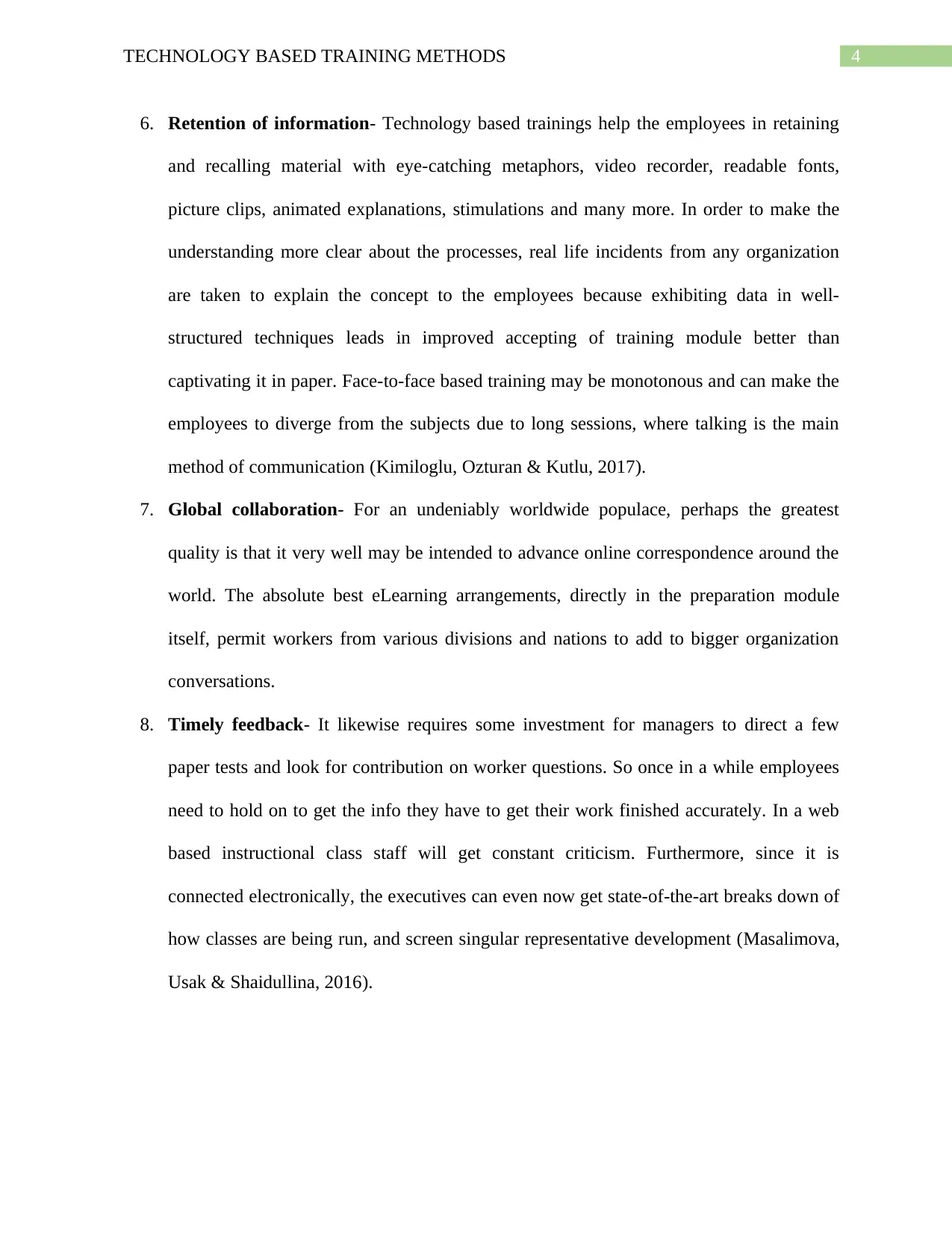
4TECHNOLOGY BASED TRAINING METHODS
6. Retention of information- Technology based trainings help the employees in retaining
and recalling material with eye-catching metaphors, video recorder, readable fonts,
picture clips, animated explanations, stimulations and many more. In order to make the
understanding more clear about the processes, real life incidents from any organization
are taken to explain the concept to the employees because exhibiting data in well-
structured techniques leads in improved accepting of training module better than
captivating it in paper. Face-to-face based training may be monotonous and can make the
employees to diverge from the subjects due to long sessions, where talking is the main
method of communication (Kimiloglu, Ozturan & Kutlu, 2017).
7. Global collaboration- For an undeniably worldwide populace, perhaps the greatest
quality is that it very well may be intended to advance online correspondence around the
world. The absolute best eLearning arrangements, directly in the preparation module
itself, permit workers from various divisions and nations to add to bigger organization
conversations.
8. Timely feedback- It likewise requires some investment for managers to direct a few
paper tests and look for contribution on worker questions. So once in a while employees
need to hold on to get the info they have to get their work finished accurately. In a web
based instructional class staff will get constant criticism. Furthermore, since it is
connected electronically, the executives can even now get state-of-the-art breaks down of
how classes are being run, and screen singular representative development (Masalimova,
Usak & Shaidullina, 2016).
6. Retention of information- Technology based trainings help the employees in retaining
and recalling material with eye-catching metaphors, video recorder, readable fonts,
picture clips, animated explanations, stimulations and many more. In order to make the
understanding more clear about the processes, real life incidents from any organization
are taken to explain the concept to the employees because exhibiting data in well-
structured techniques leads in improved accepting of training module better than
captivating it in paper. Face-to-face based training may be monotonous and can make the
employees to diverge from the subjects due to long sessions, where talking is the main
method of communication (Kimiloglu, Ozturan & Kutlu, 2017).
7. Global collaboration- For an undeniably worldwide populace, perhaps the greatest
quality is that it very well may be intended to advance online correspondence around the
world. The absolute best eLearning arrangements, directly in the preparation module
itself, permit workers from various divisions and nations to add to bigger organization
conversations.
8. Timely feedback- It likewise requires some investment for managers to direct a few
paper tests and look for contribution on worker questions. So once in a while employees
need to hold on to get the info they have to get their work finished accurately. In a web
based instructional class staff will get constant criticism. Furthermore, since it is
connected electronically, the executives can even now get state-of-the-art breaks down of
how classes are being run, and screen singular representative development (Masalimova,
Usak & Shaidullina, 2016).
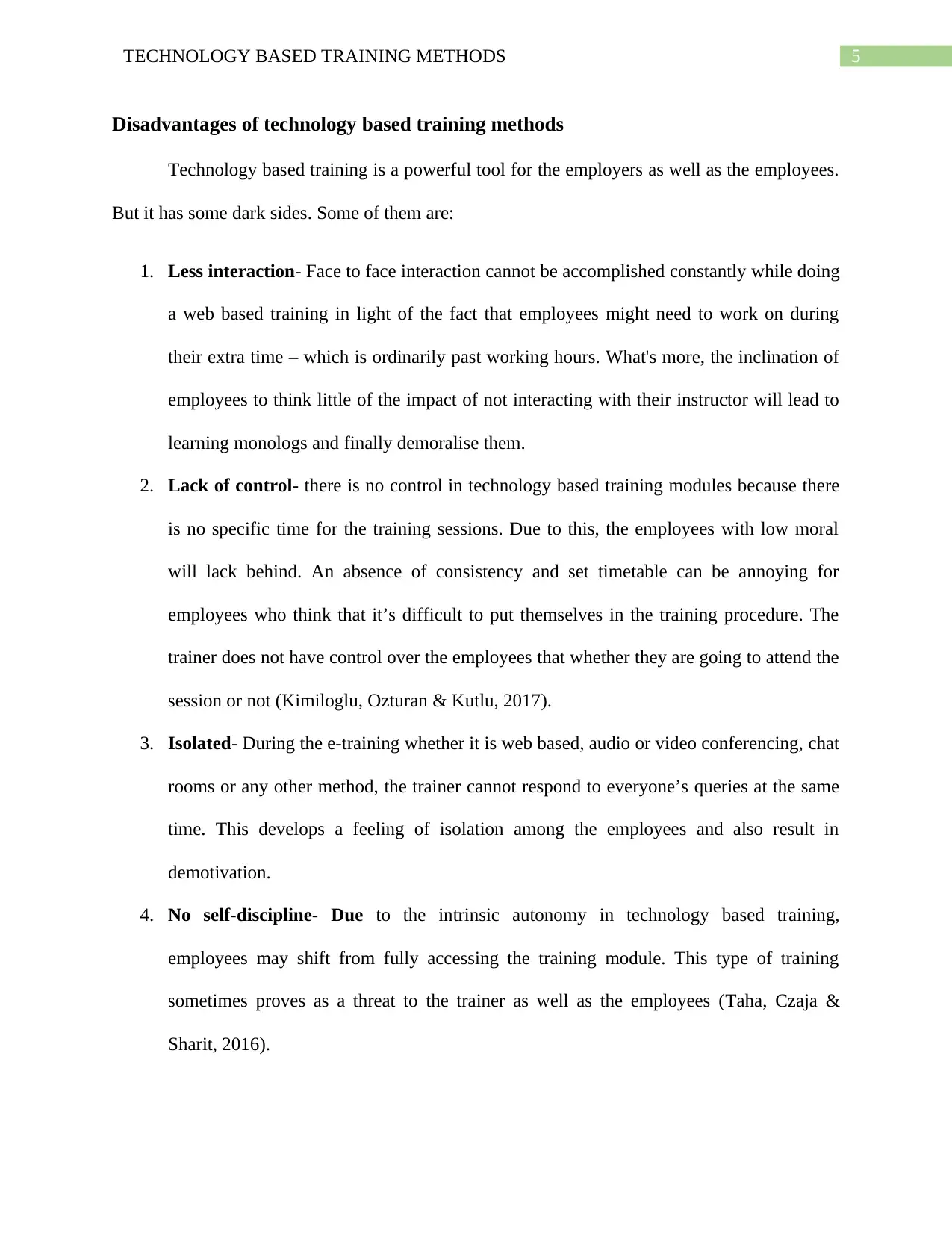
5TECHNOLOGY BASED TRAINING METHODS
Disadvantages of technology based training methods
Technology based training is a powerful tool for the employers as well as the employees.
But it has some dark sides. Some of them are:
1. Less interaction- Face to face interaction cannot be accomplished constantly while doing
a web based training in light of the fact that employees might need to work on during
their extra time – which is ordinarily past working hours. What's more, the inclination of
employees to think little of the impact of not interacting with their instructor will lead to
learning monologs and finally demoralise them.
2. Lack of control- there is no control in technology based training modules because there
is no specific time for the training sessions. Due to this, the employees with low moral
will lack behind. An absence of consistency and set timetable can be annoying for
employees who think that it’s difficult to put themselves in the training procedure. The
trainer does not have control over the employees that whether they are going to attend the
session or not (Kimiloglu, Ozturan & Kutlu, 2017).
3. Isolated- During the e-training whether it is web based, audio or video conferencing, chat
rooms or any other method, the trainer cannot respond to everyone’s queries at the same
time. This develops a feeling of isolation among the employees and also result in
demotivation.
4. No self-discipline- Due to the intrinsic autonomy in technology based training,
employees may shift from fully accessing the training module. This type of training
sometimes proves as a threat to the trainer as well as the employees (Taha, Czaja &
Sharit, 2016).
Disadvantages of technology based training methods
Technology based training is a powerful tool for the employers as well as the employees.
But it has some dark sides. Some of them are:
1. Less interaction- Face to face interaction cannot be accomplished constantly while doing
a web based training in light of the fact that employees might need to work on during
their extra time – which is ordinarily past working hours. What's more, the inclination of
employees to think little of the impact of not interacting with their instructor will lead to
learning monologs and finally demoralise them.
2. Lack of control- there is no control in technology based training modules because there
is no specific time for the training sessions. Due to this, the employees with low moral
will lack behind. An absence of consistency and set timetable can be annoying for
employees who think that it’s difficult to put themselves in the training procedure. The
trainer does not have control over the employees that whether they are going to attend the
session or not (Kimiloglu, Ozturan & Kutlu, 2017).
3. Isolated- During the e-training whether it is web based, audio or video conferencing, chat
rooms or any other method, the trainer cannot respond to everyone’s queries at the same
time. This develops a feeling of isolation among the employees and also result in
demotivation.
4. No self-discipline- Due to the intrinsic autonomy in technology based training,
employees may shift from fully accessing the training module. This type of training
sometimes proves as a threat to the trainer as well as the employees (Taha, Czaja &
Sharit, 2016).
⊘ This is a preview!⊘
Do you want full access?
Subscribe today to unlock all pages.

Trusted by 1+ million students worldwide
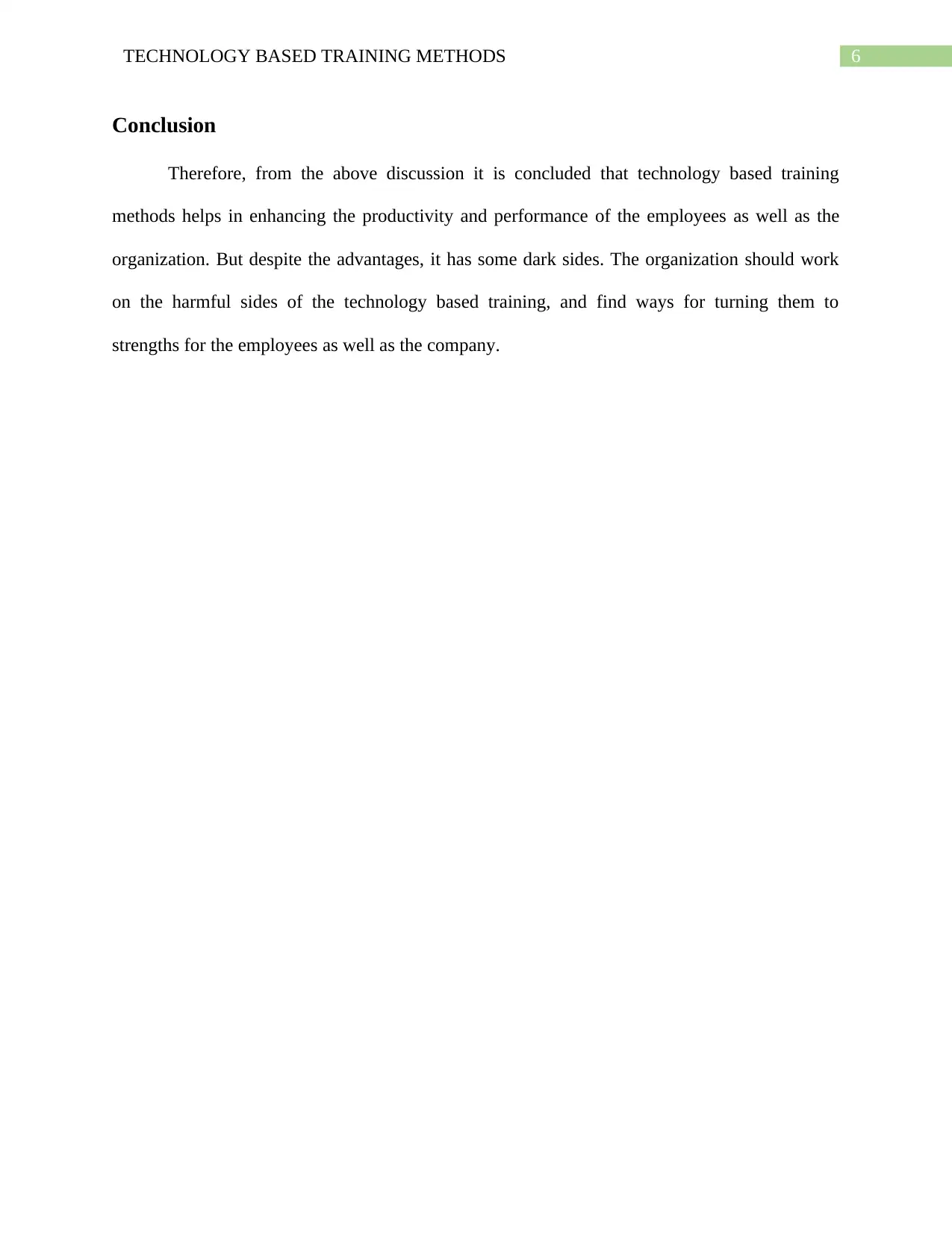
6TECHNOLOGY BASED TRAINING METHODS
Conclusion
Therefore, from the above discussion it is concluded that technology based training
methods helps in enhancing the productivity and performance of the employees as well as the
organization. But despite the advantages, it has some dark sides. The organization should work
on the harmful sides of the technology based training, and find ways for turning them to
strengths for the employees as well as the company.
Conclusion
Therefore, from the above discussion it is concluded that technology based training
methods helps in enhancing the productivity and performance of the employees as well as the
organization. But despite the advantages, it has some dark sides. The organization should work
on the harmful sides of the technology based training, and find ways for turning them to
strengths for the employees as well as the company.
Paraphrase This Document
Need a fresh take? Get an instant paraphrase of this document with our AI Paraphraser
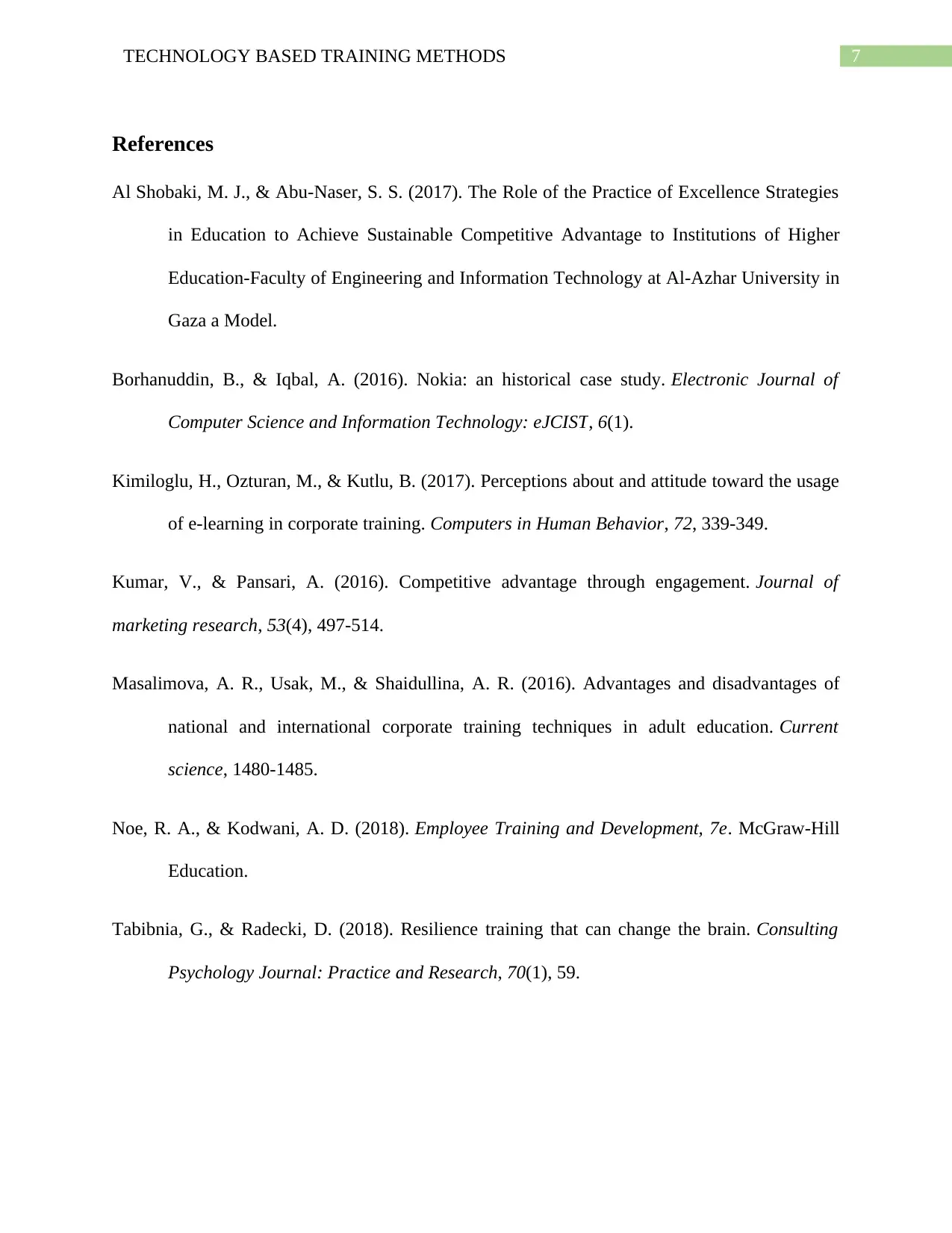
7TECHNOLOGY BASED TRAINING METHODS
References
Al Shobaki, M. J., & Abu-Naser, S. S. (2017). The Role of the Practice of Excellence Strategies
in Education to Achieve Sustainable Competitive Advantage to Institutions of Higher
Education-Faculty of Engineering and Information Technology at Al-Azhar University in
Gaza a Model.
Borhanuddin, B., & Iqbal, A. (2016). Nokia: an historical case study. Electronic Journal of
Computer Science and Information Technology: eJCIST, 6(1).
Kimiloglu, H., Ozturan, M., & Kutlu, B. (2017). Perceptions about and attitude toward the usage
of e-learning in corporate training. Computers in Human Behavior, 72, 339-349.
Kumar, V., & Pansari, A. (2016). Competitive advantage through engagement. Journal of
marketing research, 53(4), 497-514.
Masalimova, A. R., Usak, M., & Shaidullina, A. R. (2016). Advantages and disadvantages of
national and international corporate training techniques in adult education. Current
science, 1480-1485.
Noe, R. A., & Kodwani, A. D. (2018). Employee Training and Development, 7e. McGraw-Hill
Education.
Tabibnia, G., & Radecki, D. (2018). Resilience training that can change the brain. Consulting
Psychology Journal: Practice and Research, 70(1), 59.
References
Al Shobaki, M. J., & Abu-Naser, S. S. (2017). The Role of the Practice of Excellence Strategies
in Education to Achieve Sustainable Competitive Advantage to Institutions of Higher
Education-Faculty of Engineering and Information Technology at Al-Azhar University in
Gaza a Model.
Borhanuddin, B., & Iqbal, A. (2016). Nokia: an historical case study. Electronic Journal of
Computer Science and Information Technology: eJCIST, 6(1).
Kimiloglu, H., Ozturan, M., & Kutlu, B. (2017). Perceptions about and attitude toward the usage
of e-learning in corporate training. Computers in Human Behavior, 72, 339-349.
Kumar, V., & Pansari, A. (2016). Competitive advantage through engagement. Journal of
marketing research, 53(4), 497-514.
Masalimova, A. R., Usak, M., & Shaidullina, A. R. (2016). Advantages and disadvantages of
national and international corporate training techniques in adult education. Current
science, 1480-1485.
Noe, R. A., & Kodwani, A. D. (2018). Employee Training and Development, 7e. McGraw-Hill
Education.
Tabibnia, G., & Radecki, D. (2018). Resilience training that can change the brain. Consulting
Psychology Journal: Practice and Research, 70(1), 59.

8TECHNOLOGY BASED TRAINING METHODS
Taha, J., Czaja, S. J., & Sharit, J. (2016). Technology training for older job-seeking adults: The
efficacy of a program offered through a university-community collaboration. Educational
Gerontology, 42(4), 276-287.
Taha, J., Czaja, S. J., & Sharit, J. (2016). Technology training for older job-seeking adults: The
efficacy of a program offered through a university-community collaboration. Educational
Gerontology, 42(4), 276-287.
⊘ This is a preview!⊘
Do you want full access?
Subscribe today to unlock all pages.

Trusted by 1+ million students worldwide
1 out of 9
Related Documents
Your All-in-One AI-Powered Toolkit for Academic Success.
+13062052269
info@desklib.com
Available 24*7 on WhatsApp / Email
![[object Object]](/_next/static/media/star-bottom.7253800d.svg)
Unlock your academic potential
Copyright © 2020–2025 A2Z Services. All Rights Reserved. Developed and managed by ZUCOL.



